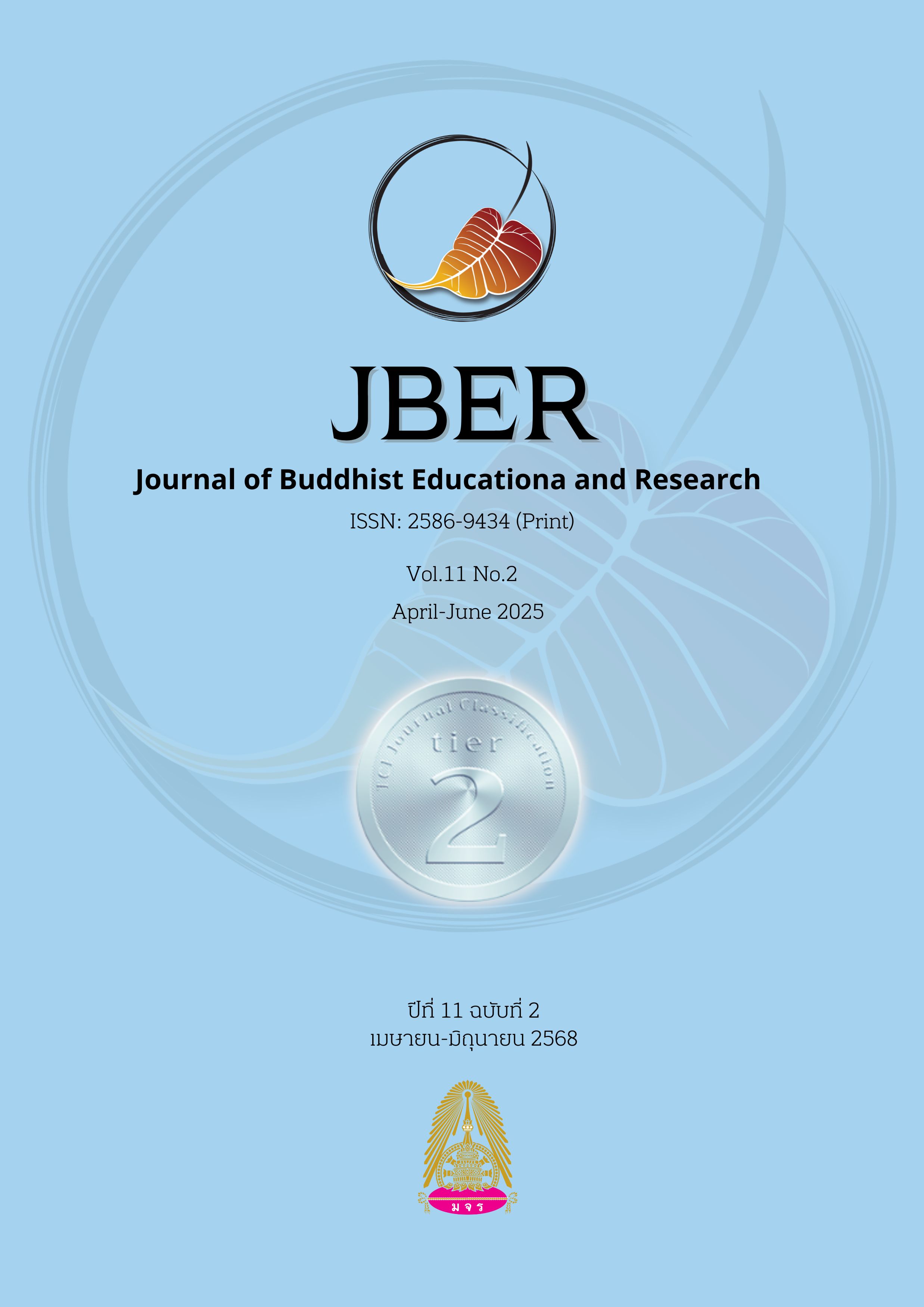แนวทางการพัฒนาภาวะผู้นำในศตวรรษที่ 21 ของผู้บริหารสถานศึกษาสังกัดสำนักงานเขตพื้นที่การศึกษาประถมศึกษาขอนแก่น เขต 3
คำสำคัญ:
แนวทาง, ภาวะผู้นำในศตวรรษที่ 21, สภาพปัจจุบัน, สภาพที่พึงประสงค์บทคัดย่อ
การวิจัยมีวัตถุประสงค์เพื่อศึกษา 1) สภาพปัจจุบัน สภาพที่พึงประสงค์และความต้องการจำเป็นภาวะผู้นำในศตวรรษที่ 21 ของผู้บริหารสถานศึกษา สังกัดสำนักงานเขตพื้นที่การศึกษาประถมศึกษาขอนแก่น เขต 3 และ 2) แนวทางการพัฒนาภาวะผู้นำในศตวรรษที่ 21 ของผู้บริหารสถานศึกษา สังกัดสำนักงานเขตพื้นที่การศึกษาประถมศึกษาขอนแก่น เขต 3 วิจัยนี้ เป็นการวิจัยแบบผสมผสาน กลุ่มตัวอย่างเป็นผู้บริหารสถานศึกษาและครู จำนวน 297 คน กำหนดขนาดกลุ่มตัวอย่างโดย เปิดตารางของเครจซี่และมอร์แกน โดยสุ่มแบบแบ่งชั้นภูมิ และสุ่มตัวอย่างแบบง่าย เครื่องมือที่ใช้ใน การวิจัย แบบสอบถามมาตรประมาณค่า 5 ระดับ แบบสัมภาษณ์กึ่งโครงสร้าง แบบประเมิน ความเหมาะสมและความเป็นไปได้ ค่าดัชนีความสอดคล้องมีค่าเท่ากับ 0.8 -1.00 ค่าอำนาจจำแนกรายข้ออยู่ระหว่าง 0.45 - 0.89 และค่าความเชื่อมั่นของแบบสอบถามทั้งฉบับเท่ากับ 0.99 สถิติที่ใช้ในการวิเคราะห์ข้อมูล ได้แก่ ร้อยละ ค่าเฉลี่ย ส่วนเบี่ยงเบนมาตรฐาน ดัชนีลำดับความสำคัญของความต้องการจำเป็น (PNImodified) และการวิเคราะห์เนื้อหา ผลการวิจัยพบว่า 1. สภาพปัจจุบัน โดยรวมอยู่ในระดับมาก ( = 3.91) และเมื่อพิจารณาเป็นรายด้านพบว่า ทุกด้านอยู่ในระดับมาก ด้านที่มีค่าเฉลี่ยสูงสุดคือ ด้านการสร้างและปรับเปลี่ยนวิสัยทัศน์สู่สังคมยุคดิจิทัล ( = 3.95) และด้านที่มีค่าเฉลี่ยต่ำสุด คือ ด้านการพัฒนาความเชี่ยวชาญสู่ความเป็นมืออาชีพ ( =3.88 ) 2. สภาพที่พึงประสงค์ของภาวะผู้นำทางวิชาการในศตวรรษที่ 21 ของผู้บริหารสถานศึกษา สังกัดสำนักงานเขตพื้นที่การศึกษาประถมศึกษาขอนแก่น เขต 3 โดยรวมอยู่ในระดับมากที่สุด ( = 4.79) และเมื่อพิจารณาเป็นรายด้าน พบว่า ทุกด้านอยู่ในระดับมากที่สุด ด้านที่มีค่าเฉลี่ยสูงสุดคือ ด้านการเปิดรับองค์ความรู้ใหม่สร้างสังคมแห่งปัญญา ( =4.86 ) และด้านที่มีค่าเฉลี่ยต่ำสุด คือ ด้านการสร้างและปรับเปลี่ยนวิสัยทัศน์สู่สังคมยุคดิจิทัล ( =4.74) 3. การประเมินความต้องการจำเป็นของภาวะผู้นำทางวิชาการในศตวรรษที่ 21 ของผู้บริหารสถานศึกษา สังกัดสำนักงานเขตพื้นที่การศึกษาประถมศึกษาขอนแก่น เขต 3 พบว่าโดยรวม มีค่าดัชนีความต้องการจำเป็น PNImodified=0.2249 และเมื่อพิจารณาเป็นรายด้าน เรียงลำดับจากมากไปหาน้อย ได้แก่ ด้านการพัฒนาความเชี่ยวชาญสู่ความเป็นมืออาชีพ มีค่าดัชนีความต้องการจำเป็นมากที่สุด (PNImodified=0.2448) ด้านการเปิดรับองค์ความรู้ใหม่สร้างสังคมแห่งปัญญา มีค่าดัชนีความต้องการจำเป็น (PNImodified=0.2398) ด้านการส่งเสริมการใช้เทคโนโลยีสารสนเทศ มีค่าดัชนีความต้องการจำเป็น (PNImodified=0.2211) ด้านการคิดค้นนวัตกรรมหรือบริการใหม่ๆ มีค่าดัชนีความต้องการจำเป็น (PNImodified = 0.2188) และด้านการสร้างและปรับเปลี่ยนวิสัยทัศน์สู่สังคมยุคดิจิทัล มีค่าดัชนีความต้องการจำเป็น (PNImodified=0.2000) ตามลำดับ 4. แนวทางในการพัฒนาภาวะผู้นำในศตวรรษที่ 21 ของผู้บริหารสถานศึกษา สังกัดสำนักงานเขตพื้นที่การศึกษาประถมศึกษาขอนแก่น เขต 3 ประกอบด้วย 5 ด้าน 15 แนวทาง ดังนี้ 1) ด้านการพัฒนาความเชี่ยวชาญสู่ความเป็นมืออาชีพ มี 3 แนวทาง 2) ด้านการเปิดรับองค์ความรู้ใหม่สร้างสังคมแห่งปัญญา มี 3 แนวทาง 3) ด้านการส่งเสริมการใช้เทคโนโลยีสารสนเทศ มี 3 แนวทาง 4) ด้านการคิดค้นนวัตกรรมหรือบริการใหม่ๆ มี 3 แนวทาง และ 5) ด้านการสร้างและปรับเปลี่ยนวิสัยทัศน์สู่สังคมยุคดิจิทัล มี 3 แนวทาง โดยภาพรวมมีผลการประเมินความเหมาะสมอยู่ใน ระดับมากที่สุด มีค่าเฉลี่ยเท่ากับ 4.93 และมีผลการประเมินความเป็นไปได้อยู่ในระดับมากที่สุด มีค่าเฉลี่ยเท่ากับ 4.77
เอกสารอ้างอิง
กรรณิกา เรดมอนด์. (2559). ตัวบ่งชี้ทักษะภาวะผู้นำในศตวรรษที่ 21 สำหรับผู้บริหารสถานศึกษาขั้นพื้นฐาน.
เฉลิมพล วงศ์พระลับ. (2563). ภาวะผู้นำดิจิทัลของผู้บริหารสถานศึกษาในศตวรรษที่ 21 ของสถานศึกษาในสังกัดอาชีวศึกษาจังหวัดขอนแก่น (วิทยานิพนธ์ ศษ.ม.). มหาวิทยาลัยภาคตะวันออกเฉียงเหนือ.
ชีวิน อ่อนละออ, และคณะ. (2563). ภาวะผู้นำยุคดิจิทัลสำหรับนักบริหารการศึกษา. วารสารวิทยาลัยบัณฑิตเอเชีย, 10(1), 108–119.
ทินกร บัวชู. (2562). ภาวะผู้นำดิจิทัลของผู้บริหารสถานศึกษา. วารสารครุศาสตร์สาร มหาวิทยาลัยราชภัฏเพชรบุรี, 13(2), 285–594.
บุญชม ศรีสะอาด. (2556). วิธีการทางสถิติสำหรับการวิจัย เล่ม 1. กรุงเทพฯ: สุวีริยาสาส์น.
สุกัญญา แช่มช้อย. (2558). ภาวะผู้นำทางเทคโนโลยี: การนำเทคโนโลยีสู่ห้องเรียนและสถานศึกษาในศตวรรษที่ 21. วารสารศึกษาศาสตร์ มหาวิทยาลัยนเรศวร, 17(4), 216–224.
เอกรัตน์ เชื้อวังคำ. (2564). องค์ประกอบของภาวะผู้นำดิจิทัลของผู้บริหารสถานศึกษา สำนักงานเขตพื้นที่การศึกษาประถมศึกษาอุดรธานี เขต 4. ใน การประชุมวิชาการเสนอผลงานวิจัยระดับบัณฑิตศึกษาแห่งชาติครั้งที่ 22 (หน้า 886–889). ขอนแก่น: มหาวิทยาลัยขอนแก่น.
Bass, B. M. (1990). Bass and Stogdill’s handbook of leadership: Theory, research, and managerial applications (3rd ed.). New York: Free Press.
DuBrin, A. J. (1995). Leadership: Research findings, practice, & skills. Boston: Houghton Mifflin.
Kramlinger, T. (1992). Training’s role in a learning organization. Training, 29(July), 46–49.
Tashakkori, A., & Teddlie, C. (2003). Handbook of mixed methods in social and behavioral research. Thousand Oaks, CA: Sage.
Watson, S. H. (2000). Leadership requirements in the 21st century: The perceptions of Canadian private sector leaders. Dissertation Abstracts International, 13(1), 43–57.
ดาวน์โหลด
เผยแพร่แล้ว
รูปแบบการอ้างอิง
ฉบับ
ประเภทบทความ
หมวดหมู่
สัญญาอนุญาต
ลิขสิทธิ์ (c) 2025 Journal of Buddhist Education and Research (Online)

อนุญาตภายใต้เงื่อนไข Creative Commons Attribution-NonCommercial-NoDerivatives 4.0 International License.





